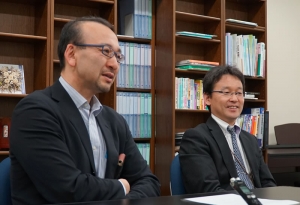Delve Deeper: Understanding the Neuroscience behind Disaster Recovery (Part 3 of 3)
Nicole Gunawansa | July 13th, 2015
This interview was held on April 21st, 2015 in the IDAC "Smart Aging" Building
Part 3- Advancing Disaster Neuroscience
Question 7: What additional projects would you like to see Tohoku Medical Megabank Organization take on in the future?
Dr. Taki: We are interested in a comparison between healthy participants and those with disorders such as PTSD, depression, and dementia related to the disaster. This data that we are currently not collecting is important in order to learn about the mechanisms of these diseases. Additionally, we hope to study changes in MRI brain composition of subjects within the autism spectrum considering that recent research shows that this population has worsening symptoms following a disaster.
Question 8: In what ways do you think you, or your work has changed from the time of the disaster? Additionally, how far do you think Japan has come since 3/11?
Dr. Taki: Honestly, I was very lucky because my hometown was safe, the return of electricity was only slightly delayed after the disaster, and use of water was manageable at my home. I felt somewhat guilty for living so comfortably compared to those in temporary housing, so I helped with disaster relief efforts in order to give back to the community and help those less fortunate. Aside from feeling a greater need to help the Tohoku region recover from 3/11, I and my interest have not changed much following the disaster seeing as I have continued to be interested in disaster related neuroscience.
Japan has come a long way since 3/11, specifically due to gracious volunteer support. Interestingly, opinions on volunteerism have improved dramatically since the disaster seeing as the Japanese people now appreciate the benefit of such programs/efforts. Nevertheless, while Japan (for the most part) has recovered, I feel that people have forgotten about the disaster. Even two to three months after the Great East Japan Earthquake people in Sendai began to live comfortably again, but when visiting the coast (i.e. Kesennuma, Minamisanriku, Ishinomaki, etc.) are you reminded that recovery is still in progress for those greatest affected.
Dr. Sekiguchi: Before the disaster, my research focused on psychosomatic medicine, specifically the impact of social stress on the body and mind. Now, my research has narrowed to evaluate the negative implications of disaster stress. I still have psychosomatic interests, and I will continue to explore this area with survivors as well.  For example, I will now analyze body symptoms which are difficult to explain, indicating potential subclinical levels of mental distress, PTSD, or depression, in disaster affected populations. In Japan, there is a culture in which people hide mental distress, but freely express body symptoms; perhaps many of these body symptoms are tied to/originate from mental stress, and I would like to evaluate this more in depth. My prior clinical and research area and my current interests are interconnected, and are both important to advance the field of disaster medicine. I echo Dr. Taki’s sentiments about Japan. The coastal areas of the Tohoku region have only been cleaned up, not recovered.
For example, I will now analyze body symptoms which are difficult to explain, indicating potential subclinical levels of mental distress, PTSD, or depression, in disaster affected populations. In Japan, there is a culture in which people hide mental distress, but freely express body symptoms; perhaps many of these body symptoms are tied to/originate from mental stress, and I would like to evaluate this more in depth. My prior clinical and research area and my current interests are interconnected, and are both important to advance the field of disaster medicine. I echo Dr. Taki’s sentiments about Japan. The coastal areas of the Tohoku region have only been cleaned up, not recovered.
| Comments from the Interviewer Having a degree in Neuroscience, I found the information that Dr. Taki and Dr. Sekiguchi shared to be incredibly fascinating, comprehensible, and educational. Although our conversation was research heavy, I learned a great deal about disaster medicine in relation to neuroimaging, an area which has begun to provide innovative insight into the resilience of disaster affected populations. Dr. Taki and Dr. Sekiguchi’s plans to expand their research technique to include other neuroimaging techniques is promising, and will undeniably provide better understanding of the mechanisms and (perhaps) origins of degenerative cognitive diseases in relation to disaster stress. I look forward to hearing about the results of ToMMo’s neuroimaging projects in the future, and hope this cohort based analysis unlocks more information about the ever enigmatic brain. Like many others I have interviewed in this series, Dr. Taki and Dr. Sekiguchi expressed concern about the current lack of remembrance regarding 3/11. As time passes it is understandable that humans forget, but there is a cost to our selective memory: those greatest affected by the disaster continue to suffer as resources and motivation from the initial relief efforts dwindle. It is important that all member of a community/country affected by a natural or man-made disaster continue to support in recovery efforts. The memory of a disaster must live on in order to promote unified reconstruction and to cultivate an increased sense of community resilience. |
